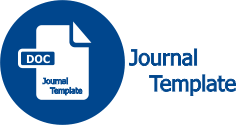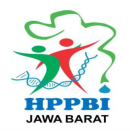Arbuscula Mycorrhizal Fungi on The Rhizosphere Three in The Ex-Sand Mine at Cipancur-Kuningan West Java
DOI:
https://doi.org/10.25134/quagga.v16i1.87Keywords:
FMA; Penambangan Pasir; rhizosferAbstract
Sand and stone mining activities in Kuningan Regency cause damage to soil and environmental ecosystems, so reclamation and revegetation are carried out. The purpose of this study is to determine the existence of indigenous / local Arbuscular Mycorrhizal Fungi (FMA) found in the rhizozofer stands of Sengon (Paraserianthes falcataria) and Acacia (Acacia mangium) which are revegetation plants on the land of former sand and stone mines Cipancur village, Kalimanggis district, Kuningan regency. Sampling using the composite sampling method, FMA isolation technique using the wet pour method is then continued with the centrifugation technique and root colonization observation technique using the root staining technique (staining). The temperature of the ex-mining soil ranges from 28C – 29C, the soil pH is 5.5 including acidic, the soil moisture varies between wet, medium (slightly wet) and dry (dry) but during the rainy season the soil will become wet and even flooded. The results showed that there were 5 genera, it are Acaulospora, Glomus, Gigaspora, Sclerocytis and Scutellospora. The dominant genus is Glomus. The highest spore density was found in Sengon stands with 1,157 spores per 50 grams of soil. The highest percentage of AMF infection was at the root of Sengon stands at 69% from the ex-sand mining area.
References
Anggreiny, Y., Nazip, K., & Santri, DJ (2017, October). Identification of arbuscular mycorrhizal fungi (AMF) in rhizosphere plants in revegetation areas of tin mining land in Merawang District, Bangka Regency and their contribution to high school biology learning. In the 2021 National Science Education Seminar (Vol. 1, No. 1, pp. 391-403).
Ansiga, R. E., Rumambi, A., Kaligis, D., Mansur, I., & Kaunang, W. (2017). EKSPLORASI FUNGI MIKORIZA ARBUSKULA (FMA) PADA RIZOSFIR HIJAUAN PAKAN. In Zootek" Journal ) (Vol. 37, Issue 1).
Brundrett MC, Bougher N, Dells B, Grove T, Malajczuk N. 1996. Working with Mycorrhizas in Forestry and Agliculture. Canberra : Australian Centere for International Agricultural Research.
Delvian and Elvianti. 2016. Seasonal Variations and Distribution of Arbuscular Mycorrhizal Fungi in Oil Palm Planting Areas. National Biodiversity Seminar, Depok
Garg, N and Chandel, S., 2010. Arbuscular Mycorrhizal Tissue: Process and Function. An Overview. Agronomy. Maintain. Dev. 30:581-599.
Herjuna. 2011. Post-mining land degradation and reclamation efforts: Book I. Pages 283-293. In Excess. HITI National Congress.
Karyaningsih I., Nurlaila A., Herlina N, 2022. Growth of Potential Food Crops on Ex-Sand Mining Land. Brass ː PT. Edukati Inti Cemerlang.
Khoirunnisa, FF 2015. Indigenous Arbuscular Mycorrhizal Fungi (AMF) in the Sengon Rhizosphere (Falcataria moluccana (Miq.) Barneby & JW Grimes) and their Contribution to High School Biology Learning. Thesis. Indralaya: Faculty of Teacher Training and Education, UNSRI.
Kurnia, G., & Larekeng, SH, 2019. Identification And Characterization Of Mycorrization In Nyatoh Stands. Perennial Journal, 15(1), 51-57
Lica, E. N. L., Matinahoru, J. M., & Hadijah, M. H. (2022). EKSPLORASI FUNGI MIKORIZA ARBUSKULA (FMA) PADA RHIZOSFER POHON SAMAMA (Anthocephalus macrophyllus (Roxb.) Havil). MAKILA, 16(1), 31–43. https://doi.org/10.30598/makila.v16i1.5232
Pacioni, G. (1991). Wet-sieving and decanting technique for spores extraction. https://www.researchgate.net/publication/235694404
Prasetyo, R., Sasli, I., & Ramadhan, D. T. H. (2019). Keragaman Vegetasi dan Identifikasi Fungi Mikoriza Arbuskula (FMA) Pada Lahan Bekas Tambang. Jurnal Agronomi Indonesia (Indonesian Journal of Agronomy), 47(2), 217–223. https://doi.org/10.24831/jai.v47i2.25050
Prianto, Y., Djaja, B., Rasji, & Gazali, NB (2019). Law Enforcement of Mining Without a Permit and Its Impact on Environmental Mushroom Conservation. Journal of Environmental Law Development, 1-19.
Setiadi, Y., and Setiawan, A., 2011. Study of the Status of Arbuscular Mycorrhizal Fungi in Post-Nickel Mining Rehabilitation Areas (Case Study of PT. INCO Tbk. Sorowako, South Sulawesi). Journal of Tropical Silviculture. 3(1):88-95.
Sihombing, SA, Delvian, D., & Elfianti, D. (2016). Exploration of mycorrhiza in former community gold mining land in Mandailing Natal. Peronema Forestry Science Journal, 5(3), 17-25.
Smith, SE, and Read, D., 2008. Mycorrhizal Symbiosis. Third Edition. Academic Press, Elsevier. New York.
Suharno. Tanjung, Rosye HR, Sufaati, Sufeni. 2020. Arbuscular Mycorrhizal Fungi: Gajah Mada University Press.
Sundari, S, Nurhidayati, T, and Trisnawati, I. 2011. Isolation and identification of Indigenous Mycorrhizae from Rice Tobacco Roots (Nicotiana tabacum L) in the Rice Field Area, Pemekasan Regency, Madura. Surabaya: Sepuluh November Institute of Technology.
Upadhyaya, H., Panda, SK, Bhattacharjee, MK, and Dutta, S., 2010. Role of Arbuscular Mycorrhiza in Heavy Metal Tolerance in Plants: Prospects of Phytoremediation. Journal of Phytology. 2(7): 16-27.
Wanda AR, Yuliani, Trimulyono G. 2015. Diversity of Arbuscular Vesicle Mycorrhizal Fungi (MVA) in the coastal forests of Nepa Sampang Madura based on a salinity gradient. Bio Lantern. 4(3): 180-186.




















